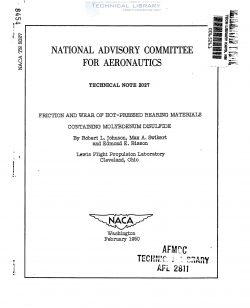naca-tn-2027
- Version
- 46 Downloads
- 1.04 MB File Size
- 1 File Count
- December 14, 2016 Create Date
- December 14, 2016 Last Updated
National Advisory Committee for Aeronautics, Technical Notes - Friction and Wear of Hot Pressed Bearing Materials Containing Molybdenum Disulfide

An experimental investigation was conducted to determine the
feasibility of bearing lubrication by a process involving the
transfer of molybdenum disulfide from within the structure of a
composite bearing material to the interface between the contacting
surfaces. The investigation was also conducted to establish the
proportionate amount of lubricant necessary in such a bearing mate-
rial. A study was made of bearing materials composed of various
amounts of molybdenum disulfide (up to 35 percent), silver, and
5-percent copper.
The experiments were performed with a kinetic-friction appa-
ratus employing a rotating steel disk and a bearing-specimen
assembly suspended and restrained by metal springs. The bearing
specimen had. a hemispherical contacting surface. Experimental runs
were made over a range of sliding velocities between 75 and
8000 feet per “minute with loads of 269, 519, and 1017 grams. Spec-
imen surfaces were studied with standardmetallurgical and physical
techniques and equipment.
The materials investigated were lubricated by a transfer of
solid. lubricant (molybdenum disulfide) from within the structure of
the rider to the interface between rider and slider. This transfer
resulted 'imthe formation of an effective lubricating film. The
best composition studied in this investigation, from considerations
of both friction and wear, contained lO-percent molybdemm disulfide.
This composition showed the lowest rate of wear and relatively low
friction (approaching the lowest obtained); the friction for this
material was relatively unaffected by sliding velocity. Surface
welding occurred with specimens containing less than 5-percent
molybdenum disulfide.
Some of the conditions under which aircraft-propulsion systems
must operate can result in extreme boundary lubrication between the
contacting surfaces; at these conditions, some metal-to-metal con-
tact would result. As an example, Gurney in reference 1 states that
the temperatures attained in rolling-contact bearings after shutdown
can result in vaporization of the lubricant, which permits metal-to-
metal contact on subsequent starting of the engine. Bearing mate-
rials containing a solid lubricant prepared by powder-metallurg
techniques might be suitable for reducing friction and preventing
welding under conditions of metal-to-metal contact.
| File | Action |
|---|---|
| naca-tn-2027 Friction and Wear of Hot Pressed Bearing Materials Containing Molybdenum Disulfide.pdf | Download |
Comment On This Post